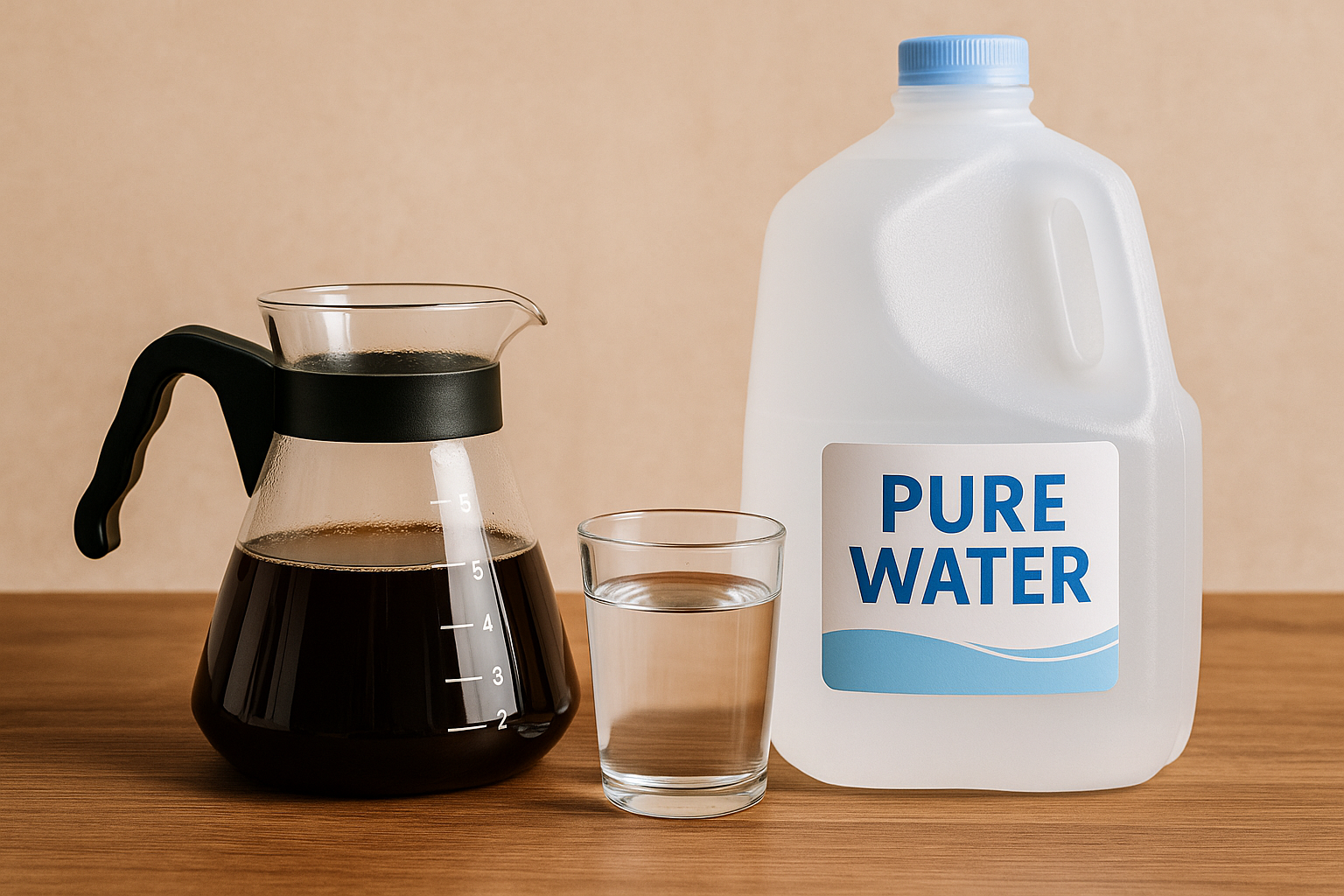You might buy the freshest beans, grind them precisely, and brew with top-tier equipment—but if your water isn’t right, your coffee will suffer.
That’s because coffee is more than 98% water, and water isn’t just H₂O—it’s a solution full of minerals, gases, and chemical properties that dramatically affect how your coffee tastes.
In this guide, you’ll learn how water impacts coffee extraction, which water types to avoid, what minerals are essential, and how to choose or create the best water for brewing—whether you’re pulling espresso, pouring over, or making a French Press.
Why Water Matters in Coffee Brewing
When you brew coffee, you’re not just mixing water with solids. You’re extracting soluble compounds—acids, sugars, oils, and aromatic molecules—from ground beans into liquid. The minerals in water act like chemical agents that interact with those compounds.
If the water is too hard, it might over-extract and cause bitterness. If it’s too soft or pure, it might under-extract and lead to weak, flat coffee. Ideal water strikes a balance—extracting enough flavor compounds while avoiding excessive bitterness or dullness.
Key Chemical Properties of Water
1. Total Dissolved Solids (TDS)
Measures the total minerals dissolved in water, usually in ppm (parts per million).
- Ideal range for coffee: 75–250 ppm
- Too low (<50 ppm): Under-extraction, sour or flat taste
- Too high (>300 ppm): Over-extraction, harsh or muddy taste
2. Hardness
Primarily made up of calcium and magnesium ions, which bind to flavor compounds.
- Ideal hardness: 50–175 ppm
- Magnesium enhances fruity, acidic notes
- Calcium brings out body and depth
3. Alkalinity
Also called buffering capacity, alkalinity resists changes in pH.
- Ideal alkalinity: 40–70 ppm
- Too high: Mutes flavor
- Too low: Overly sharp acidity
4. pH Level
Coffee prefers slightly acidic water.
- Ideal pH: ~6.5–7.0
- Too acidic (<6): Sharp, sour flavors
- Too alkaline (>7.5): Flat, dull taste
Types of Water and Their Effects on Coffee
| Water Type | Pros | Cons | Verdict |
|---|---|---|---|
| Tap Water | Convenient, cheap | Variable quality, chlorine, hardness | Use only with good filtration |
| Bottled Spring Water | Balanced minerals, consistent | Expensive over time | Good for casual brewing |
| Distilled Water | Pure, no minerals | Terrible extraction, flat taste | Avoid completely |
| Reverse Osmosis (RO) | Nearly pure, customizable | Must remineralize or blend | Great with adjustments |
| Third Wave Water | Mineralized for coffee | Best flavor control | Excellent (add to RO or distilled) |
Testing Your Water at Home
Want to know what’s in your water? Use:
- TDS Meter – Measures total dissolved solids (around $15)
- Water Hardness Test Strips – Quick way to check for calcium/magnesium
- Local Water Report – Often available from your municipality
If your tap water is:
- Soft (<50 ppm) – Consider blending with bottled or mineral-enhanced water
- Hard (>200 ppm) – Use filtration or RO system
How to Improve Your Water for Brewing
1. Use a Home Water Filter
- Pitcher filters (Brita, PUR): Removes chlorine, some minerals
- Under-sink filters: More comprehensive; remove heavy metals
- Activated carbon filters: Improve taste and remove odor
Note: These won’t always adjust mineral content to ideal levels for coffee.
2. Blend Your Own Water
Use a mix of:
- Distilled water or RO water (as a base)
- Mineral packets like Third Wave Water, Lotus Water, or DIY solutions
These allow you to tailor your mineral content for the perfect extraction profile.
3. Buy Pre-Bottled Water for Coffee
Some bottled waters work surprisingly well:
| Brand | TDS (approx.) | Notes |
|---|---|---|
| Crystal Geyser | ~120 ppm | Good mineral balance |
| Volvic | ~130 ppm | Soft and neutral taste |
| Evian | ~300 ppm | Too hard for some brew methods |
| Nestlé Pure Life | ~90 ppm | Decent option, but can vary |
Avoid:
- Dasani and Aquafina (often reverse osmosis without minerals)
Espresso and Water: Why Precision Matters More
Espresso brewing involves high pressure and very short contact time (~25–30 seconds). Water that’s too soft will under-extract. Water that’s too hard can clog machines with scale and cause inconsistent shots.
Espresso requires:
- TDS around 125–175 ppm
- Calcium and magnesium balanced
- Low alkalinity (to preserve acidity and crema)
Use a water softener, inline filter, or RO + mineral blend to protect your machine and optimize flavor.
Common Water Problems and Solutions
| Problem | Likely Cause | Fix |
|---|---|---|
| Sour, underwhelming cup | Too soft or pure water | Add minerals or blend water sources |
| Bitter or harsh brew | Excessive hardness or alkalinity | Filter or switch water |
| Lack of body | Low magnesium | Use water with better mineral mix |
| Clogged espresso machine | High calcium content (hard water) | Use filtered or softened water |
Creating “Barista Water” at Home (DIY Recipe)
Here’s a simple recipe using distilled water and minerals:
You’ll need:
- 1 gallon of distilled water
- Epsom salt (magnesium sulfate)
- Baking soda (sodium bicarbonate)
- Calcium chloride drops (optional)
Example mix (for 1 gallon):
- 0.1g Epsom salt
- 0.2g baking soda
- 1–2 drops calcium chloride
Mix well and store in a clean container. Adjust to taste with small batches.
Final Thoughts: Brew Better Coffee by Upgrading the Water
It’s easy to obsess over beans and equipment—but if you’re not paying attention to water, you’re missing a major piece of the puzzle. Whether you’re chasing sweetness in a pour-over or dialing in espresso shots, using the right water can take your coffee from good to extraordinary.
Start simple: test your tap water, filter it, and explore options like mineral packets or smart bottled water. Once you find your ideal formula, your brews will be cleaner, brighter, and far more satisfying—proving that great coffee begins with water.

Marcelo Oliveira is a coffee enthusiast and content creator specializing in barista skills, brewing methods, equipment reviews, coffee-related health insights, and fascinating curiosities from the coffee world. With a deep passion for every step of the brewing process, he turns technical knowledge into accessible and engaging content for both beginners and seasoned coffee lovers. Marcelo’s goal is to help readers appreciate the full experience of coffee—from bean to cup.
